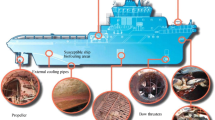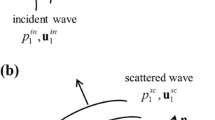Abstract
Aquatic organisms such as copepods exhibit remarkable responses to changes in ambient flows, especially shear gradients, when foraging, mating and escaping. To accomplish these tasks, the sensory system of the organism must decode the local sensory measurements to detect the flow properties. Evidence suggests that organisms sense differences in the hydrodynamic signal rather than absolute values of the ambient flow. In this paper, we develop a mathematical framework for shear flow detection using a bioinspired sensory system that measures only differences in velocity. We show that the sensory system is capable of reconstructing the properties of the ambient shear flow under certain conditions on the flow sensors. We discuss these conditions and provide explicit expressions for processing the sensory measurements and extracting the flow properties. These findings suggest that by combining suitable velocity sensors and physics-based methods for decoding sensory measurements, we obtain a powerful approach for understanding and developing underwater sensory systems.






Similar content being viewed by others
References
Batchelor, G.K.: An Introduction to Fluid Dynamics. Cambridge University Press, Cambridge (2000)
Colvert, B., Chen, K., Kanso, E.: Local flow characterization using bioinspired sensory information. J. Fluid Mech. (2017, in review)
Colvert, B., Kanso, E.: Fishlike rheotaxis. J. Fluid Mech. 793, 656–666 (2016)
Fields, D. M., Weissburg, M. J.: Evolutionary and ecological significance of mechanosenor morphology: copepods as a model system. Mar. Ecol. Prog. Ser. 287, 269–274 (2005)
Haller, G.: Distinguished material surfaces and coherent structures in three-dimensional fluid flows. Phys. D 149(4), 248–277 (2001)
Kai, E.T., Rossi, V., Sudre, J., Weimerskirch, H., Lopez, C., Hernandez-Garcia, E., Marsac, F., Garçon, V.: Top marine predators track lagrangian coherent structures. Proc. Natl. Acad. Sci. 106(20), 8245–8250 (2009)
Ristroph, L., Liao, J.C., Zhang, J.: Lateral line layout correlates with the differential hydrodynamic pressure on swimming fish. Phys. Rev. Lett. 114, 018102 (2015)
Theisel, H., Seidel, H.-P.: Feature flow fields. In: Bonneau, G.-P., Hahmann, S., Hansen, C. D., (eds.) Joint Eurographics—IEEE TCVG Symposium on Visualization (2003)
Titelman, J.: Swimming and escape behavior of copepod nauplii: implications for predator-prey interactions among copepods. Mar. Ecol. Prog. Ser. 213, 203–213 (2001)
Yen, J., Lenz, P.H., Gassie, D.V., Hartline, D.K.: Mechanoreception in marine copepods: electrophysiological studies on the first antennae. J. Plankton Res. 14(4), 495–512 (1992)
Yen, J., Sehn, J.K., Catton, K., Kramer, A., Sarnelle, O.: Pheromone trail following in three dimensions by the freshwater copepod Hesperodiaptomus shoshone. J. Plankton Res. 33(6), 907–916 (2011)
Yen, J., Weissburg, M.J., Doall, M.H.: The fluid physics of signal perception by mate-tracking copepods. Philos. Trans. R. Soc. Lond. B Biol. Sci. 353, 787–804 (1998)
Acknowledgements
The work of Brendan Colvert and Eva Kanso is partially supported by the ONR Grant 14-001 (to E.K.). Brendan Colvert also acknowledges support from the Department of Defense (DoD) through the National Defense Science and Engineering Graduate Fellowship (NDSEG) Program. Kevin K. Chen was supported by the Viterbi Postdoctoral Fellowship provided by the Viterbi School of Engineering at the University of Southern California.
Author information
Authors and Affiliations
Corresponding author
Ethics declarations
Conflicts of interest
Authors declare that they have no conflict of interest.
Additional information
Communicated by Maurizio Porfiri.
Rights and permissions
About this article
Cite this article
Colvert, B., Chen, K.K. & Kanso, E. Bioinspired Sensory Systems for Shear Flow Detection. J Nonlinear Sci 27, 1183–1192 (2017). https://doi.org/10.1007/s00332-017-9365-6
Received:
Accepted:
Published:
Issue Date:
DOI: https://doi.org/10.1007/s00332-017-9365-6




